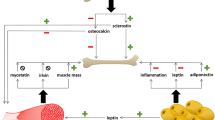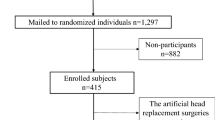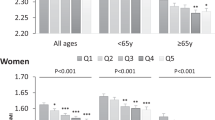Abstract
Objectives:
The aims of this study were to investigate the relationship between sarcopenia, dietary intake, nutritional indices and hip bone mineral density (BMD) in the elderly, and to estimate the risk of low BMD due to specific independent predictor thresholds.
Subjects and methods:
Body mass index (BMI), serum albumin, energy and protein intake were studied in 352 elderly outpatients (216 women aged 73.5±5.3 years and 136 men aged 73.9±5.6 years). BMD at different hip sites and appendicular skeletal muscle mass (ASMM) were assessed by dual-energy X-ray absorptiometry.
Results:
The prevalence of osteoporosis was 13% in men and 45% in women, while the prevalence of sarcopenia (50%) and hypoalbuminemia (5%) were similar in both genders. BMI, albumin and ASMM were significantly associated with BMD in both genders: so was protein intake, but only in men. By multiple regression analysis, the variables that retained their independent explanatory role on total hip BMD, were BMI and protein intake in men, and BMI and albumin in women. By logistic regression analysis, men risked having a low BMD with a BMI <22 (OR=12) and a protein intake <65.7 g/day (OR=3.7). Women carried some risk already in the BMI 25–30 class (OR=5), and a much greater risk in the BMI <22 class (OR=26). Albumin <40 g/l also emerged as an independent risk factor (OR=2.6).
Conclusions:
BMI in both genders, albumin in women and protein intake in men have an independent effect on BMD. BMI values <22 are normal for younger adults but carry a higher risk of osteoporosis in the elderly, particularly in women. Age-related sarcopenia does not seem to be involved in bone mass loss.
This is a preview of subscription content, access via your institution
Access options
Subscribe to this journal
Receive 12 print issues and online access
$259.00 per year
only $21.58 per issue
Buy this article
- Purchase on Springer Link
- Instant access to full article PDF
Prices may be subject to local taxes which are calculated during checkout

Similar content being viewed by others
References
Agarwal N, Acevedo F, Leighton LS, Cayten G, Pitchumoni CS (1988). Predictive ability of various nutritional variables for mortality in elderly people. Am J Clin Nutr 48, 1173–1178.
Allison DB, Gallagher D, Heo M, Pi-Sunyer FX, Heymsfield SB (1997). Body mass index and all-cause mortality among people age 70 and over: the Longitudinal Study of Aging. Int J Obes Relat Metab Disord 21, 424–431.
Baumgartner RN, Koehler KM, Gallagher D, Romero L, Heymsfield SB, Ross RR et al. (1998). Epidemiology of sarcopenia among the elderly in New Mexico. Am J Epidemiol 147, 755–763.
Baumgartner RN, Koehler KM, Romero L, Garry PJ (1996). Serum albumin is associated with skeletal muscle in elderly men and women. Am J Clin Nutr 64, 552–558.
Bolton CE, Ionescu AA, Shiels KM, Pettit RJ, Edwards PH, Sone MD et al. (2004). Associated loss of fat-free mass and bone mineral density in chronic obstructive pulmonary disease. Am J Resp Care Med 170, 1286–1293.
Bonjour JP, Schurch MA, Rizzoli R (1996). Nutrition aspects of hip fractures. Bone 18, 1395–1445.
Coin A, Sergi G, Beninca P, Lupoli L, Cinti G, Ferrara L et al. (2000). Bone mineral density and body composition in underweight and normal elderly subjects. Osteoporos Int 11, 1043–1050.
De Laet C, Kanis JA, Odén A, Johanson H, Johnell O, Delmas P et al. (2005). Body mass index as a predictor of fracture risk: a meta-analysis. Osteoporos Int 16, 1330–1338.
D'Erasmo E, Pisani D, Ragno A, Raejntroph N, Letizia C, Acca M (1999). Relationship between serum albumin and bone mineral density in postmenopausal women and in patients with hypoalbuminemia. Horm Metab Res J 3, 385–388.
Di Monaco M, Vallero F, Di Monaco R, Mautino F, Cavanna A (2003). Biochemical markers of nutrition and bone mineral density in the elderly. Gerontology 49, 50–54.
Edelstein SL, Barrett-Connor E (1993). Relation between body size and bone mineral density in elderly men and women. Am J Epidemiol 138, 160–169.
Felson DT, Zhang Y, Hannan MT, Anderson JJ (1993). Effects of weight and body mass index on bone mineral density in men and women: the Framingham Study. J Bone Miner Res 8, 567–572.
Frost HM (1987). The mechanostat: a proposed pathogenetic mechanism of osteoporosis and the bone mass effects of mechanical and non-mechanical agents. Bone Miner 2, 73–85.
Glynn NW, Meilahn EN, Charron M, Anderson SJ, Kuller LH, Cauley JA (1995). Determinants of bone mineral density in older men. J Bone Miner Res 10, 1769–1777.
Hampson G, Martin FC, Moffat K, Vaja S, Sankaralingam S, Cheung J et al. (2003). Effects of dietary improvement on bone metabolism in elderly underweight women with osteoporosis: a randomised controlled trial. Osteoporos Int 14, 750–756.
Hannan MT, Felson DT, Dawson-Hughes B, Tucker KL, Cupples LA, Wilson PW et al. (2000). Risk factors for longitudinal bone loss in elderly men and women: the Framingham Osteoporosis Study. J Bone Miner Res 15, 710–720.
Heymsfield SB, Smith R, Aulet M, Bensen B, Lichtman S, Wang J et al. (1990). Appendicular skeletal muscle mass: measurement by dual photon absorptiometry. Am J Clin Nutr 52, 214–218.
Huang Z, Himes JH, McGovern PG (1996). Nutrition and subsequent hip fracture risk among a national cohort of white women. Am J Epidemiol 144, 124–134.
Ilich JZ, Brownbill RA, Tamborini L (2003). Bone and nutrition in elderly women: protein, energy, and calcium as main determinants of bone mineral density. Eur J Clin Nutr 57, 554–565.
Inelmen EM, Gimenez GF, Gatto MR, Miotto F, Sergi G, Maccari T et al. (2000). Dietary intake and nutritional status in Italian elderly subjects. J Nutr Health Aging 4, 91–101.
Inelmen EM, Toffanello ED, Enzi G, Gasparini G, Miotto F, Sergi G et al. (2005). Predictors of drop-out in overweight and obese outpatients. Int J Obes 29, 122–128.
Lunde AV, Barrett-Connor E, Morton DJ (1998). Serum albumin and bone mineral density in healthy older men and women: the Rancho Bernardo Study. Osteoporos Int 8, 547–551.
Melton III LJ (2003). Adverse outcomes of osteoporotic fractures in the general population. J Bone Miner Res 18, 1139–1141.
Murphy S, Khaw KT, Cassidy A, Compston JE (1993). Sex hormones and bone mineral density in elderly men. Bone Miner 20, 133–140.
National Research Council (1989). Recommended Dietary Allowances, Report 10th edn. National Academy Press: Washington, DC.
Nguyen TV, Center JR, Eisman JA (2000). Osteoporosis in elderly men and women: effects of dietary calcium, physical activity, and body mass index. J Bone Miner Res 15, 322–331.
Rebuffe-Scrive M, Anderson B, Olbe L, Bjorntorp P (1990). Metabolism of adipose tissue in intraabdominal depots in severely obese men and women. Metabolism 39, 1021–1025.
Russo CR, Ricca M, Ferrucci L (2000). True osteoporosis and frailty-related osteopenia: two different clinical entities. J Am Geriatr Soc 48, 1738–1739.
Schurch MA, Rizzoli R, Slosman D, Vadas L, Vergnaud P, Bonjour JP (1998). Protein supplements increase serum insulin-like growth factor-I levels and attenuate proximal femur bone loss in patients with recent hip fracture. A randomized, double-blind, placebo-controlled trial. Ann Intern Med 128, 801–809.
Sergi G, Coin A, Marin S, Vianello A, Manzan A, Peruzza S et al. (2006). Body composition and resting energy expenditure in elderly male patients with chronic obstructive pulmonary disease. Respir Med 100, 1918–1924.
Sergi G, Perissinotto E, Pisent C, Buja A, Maggi S, Coin A, et al., ILSA Working Group (2005). An adequate threshold for body mass index to detect underweight condition in elderly persons: the Italian Longitudinal Study on Aging (ILSA). J Gerontol A Biol Sci Med Sci 60, 866–871.
Slemenda CW, Longcope C, Zhou L, Hui SL, Peacock M, Johnston CC (1997). Sex steroids and bone mass in older men. Positive associations with serum estrogens and negative associations with androgens. J Clin Invest 100, 1755–1759.
Taaffe DR, Cauley JA, Danielson M, Nevitt MC, Lang TF, Bauer DC et al. (2001). Race and sex effects on the association between muscle strength, soft tissue, and bone mineral density in healthy elders: the Health, Aging, and Body Composition Study. J Bone Miner Res 16, 1343–1352.
Thiebaud D, Burckhardt P, Costanza M, Sloutskis D, Gilliard D, Quinodoz F et al. (1997). Importance of albumin, 25(OH) vitamin D and IGFBP-3 as risk factors in elderly women and men with hip fracture. Osteoporosis Int 7, 457–462.
Vaananen HK, Harkonen PL (1996). Estrogen and bone metabolism. Maturitas 23, S65–S69.
Walsh MC, Hunter GR, Livingstone MB (2006). Sarcopenia in premenopausal and postmenopausal women with osteopenia, osteoporosis and normal bone mineral density. Osteoporos Int 17, 61–67.
WHO (1994). Study Group on Assessment of Fracture Risk and its Application to Screening and Postmenopausal Oseteoporosis. Publication No. 843 Geneva: World Health Organisation.
Author information
Authors and Affiliations
Corresponding author
Additional information
Contributors: AC was the principal investigator, responsible for analyzing data and writing the manuscript; EP performed all statistical analyses using SAS Statistical Software; GE and EM were responsible for recruiting subjects in Padova; MZ was responsible for recruiting subjects in Verona; EMI and LB collected and analyzed nutritional data; ACF and AB organized the database and control data; GS helped with the study and supervised the work of the whole team.
Rights and permissions
About this article
Cite this article
Coin, A., Perissinotto, E., Enzi, G. et al. Predictors of low bone mineral density in the elderly: the role of dietary intake, nutritional status and sarcopenia. Eur J Clin Nutr 62, 802–809 (2008). https://doi.org/10.1038/sj.ejcn.1602779
Received:
Revised:
Accepted:
Published:
Issue Date:
DOI: https://doi.org/10.1038/sj.ejcn.1602779
Keywords
This article is cited by
-
Prognostic Significance of Preoperative Osteopenia in Patients Undergoing Esophagectomy for Esophageal Cancer
World Journal of Surgery (2021)
-
Dietary protein and bone health across the life-course: an updated systematic review and meta-analysis over 40 years
Osteoporosis International (2019)
-
Biochemical Predictors of Low Bone Mineral Density and Fracture Susceptibility in Maltese Postmenopausal Women
Calcified Tissue International (2016)
-
Sarcopenia and sarcopenic leg as potential risk factors for acute osteoporotic vertebral fracture among older women
European Spine Journal (2016)
-
Relationship of sarcopenia and body composition with osteoporosis
Osteoporosis International (2016)



